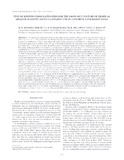Test of refined formulated feed for the grow-out culture of tropical abalone Haliotis asinina (Linnaeus 1758) in concrete land-based tanks

ຄົ້ນຫາ / ເປີດ
ວັນທີ
2016ຜູ້ຂຽນ
Page views
518Metadata
ເບິ່ງບັນທຶກລາຍລະອຽດລາຍການCited times in Scopus
Share
ບົດຄັດຫຍໍ້
A refined formulated feed for the grow-out culture of tropical abalone Haliotis asinina was evaluated to assess its suitability for a shorter culture period (<8 mo). Refinement procedures focused on the application of additional binder (sodium alginate), use of different feed forms (molo and noodle forms), and incorporation of Spirulina spp. as alternate protein source in partial replacement of other protein sources. Groups of 22 postlarval abalone with mean initial shell length (SL, 29 ± 0.01 mm) and weight (5.67 ± 0.06 g), harvested from the mollusc nursery of Southeast Asian Fisheries Development Center, Aquaculture Department in Tigbauan, Iloilo, were stocked each as replicate in five plastic trays measuring 31.7×43.5×9.0 cm. The trays were suspended in five 1×2×1-m concrete land-based tanks representing the five dietary treatments. Abalone were fed either the refined formulated diet,molo form(RF-M), refined formulated diet, noodle form(RF-N), unrefined formulated diet, noodle form(UF-N), unrefined formulated diet, molo form (UF-M), and seaweed (NF), as the reference diet. Formulated diets and natural food were given at 2%-3% and 10%-15% (wet weight) of the body weight, respectively, once daily at 1600 h for 180 days. Water quality measurements were maintained at desired levels. A flow-through filtered seawater systemwith continuous aeration was provided in each tank. A parametric one-way analysis of variance (ANOVA) and Tukey's post hoc test were used to test the differences in abalone SL, weight gain (WG), and specific growth rate (SGR) while nonparametric Kruskal-Wallis test was used for daily growth increase in SL (DGSL) and feed conversion ratio (FCR) among the various dietary treatments. Percent diet water stability and apparent digestibility coefficient for dry matter (ADMD) and apparent digestibility of seaweed as ingredient were, likewise assessed. A Hedonic scale taste test analysis was done to assess differences in abalone meat quality. Highest mean WG (239.17% ± 26.05%), mean SL increase (91.51% ± 3.28%), DGSL (2,296.67 µm/day), SGR (4.04 ± 0.27) were attained with abalone fed RF-N. Values, however, were not significantly different (P > 0.05) for all growth parameters in RF-M except for percent increase in SL at 74.25 ± 3.11. Abalone given UF-N and UF-M showed significantly lower mean WG and SL. Survival was high and was significantly different (P < 0.05) between treatments. The highest FCR was obtained with abalone fed seaweeds. Apparent digestibility for dry matter of both the RF and UF were high at 95.67% ± 1.17% and 95.95% ± 0.45%, respectively. Apparent digestibility of ingredient seaweed was 99.4% ± 1.38%. Regression analysis of data showed better percent water stability for RF (57%; R2 = 0.954) compared with UF (38%; R2 = 0.790) after 24 h. Meat quality of the final product assessed through Hedonic scale taste testing and one-way ANOVA did not show any significant variations in taste, texture, color, odor, and general acceptability. Results have demonstrated that the refinement done on the formulated feed may enable the abalone to grow to its marketable size of about 5-6 cm in a shorter culture period (180 days) in concrete land-based tanks.
Suggested Citation
Bautista-Teruel, M. N., Maquirang, J. R. H., de la Peña, M. R., & Balinas, V. T. (2016). Test of refined formulated feed for the grow-out culture of tropical abalone Haliotis asinina (Linnaeus 1758) in concrete land-based tanks. Journal of Shellfish Research , 35(3), 633-639. https://doi.org/10.2983/035.035.0309
Collections
- AQD Journal Articles [1249]
